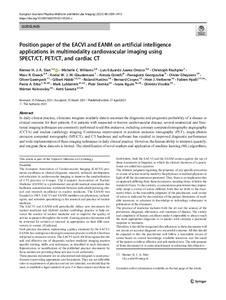Position paper of the EACVI and EANM on artificial intelligence applications in multimodality cardiovascular imaging using SPECT/CT, PET/CT, and cardiac CT
Slart Riemer H. J. A.; Williams Michelle C.; Juarez-Orozco Luis Eduardo; Rischpler Christoph; Dweck Marc R.; Glaudemans Andor W. J. M.; Gimelli Alessia; Georgoulias Panagiotis; Gheysens Olivier; Gaemperli Oliver; Habib Gilbert; Hustinx Roland; Cosyns Bernard; Verberne Hein J.; Hyafil Fabien; Erba Paola A.; Lubberink Mark; Slomka Piotr; Išgum Ivana; Visvikis Dimitris; Kolossváry Márton; Saraste Antti
Position paper of the EACVI and EANM on artificial intelligence applications in multimodality cardiovascular imaging using SPECT/CT, PET/CT, and cardiac CT
Slart Riemer H. J. A.
Williams Michelle C.
Juarez-Orozco Luis Eduardo
Rischpler Christoph
Dweck Marc R.
Glaudemans Andor W. J. M.
Gimelli Alessia
Georgoulias Panagiotis
Gheysens Olivier
Gaemperli Oliver
Habib Gilbert
Hustinx Roland
Cosyns Bernard
Verberne Hein J.
Hyafil Fabien
Erba Paola A.
Lubberink Mark
Slomka Piotr
Išgum Ivana
Visvikis Dimitris
Kolossváry Márton
Saraste Antti
SPRINGER
Julkaisun pysyvä osoite on:
https://urn.fi/URN:NBN:fi-fe2021093047965
https://urn.fi/URN:NBN:fi-fe2021093047965
Tiivistelmä
In daily clinical practice, clinicians integrate available data to ascertain the diagnostic and prognostic probability of a disease or clinical outcome for their patients. For patients with suspected or known cardiovascular disease, several anatomical and functional imaging techniques are commonly performed to aid this endeavor, including coronary computed tomography angiography (CCTA) and nuclear cardiology imaging. Continuous improvement in positron emission tomography (PET), single-photon emission computed tomography (SPECT), and CT hardware and software has resulted in improved diagnostic performance and wide implementation of these imaging techniques in daily clinical practice. However, the human ability to interpret, quantify, and integrate these data sets is limited. The identification of novel markers and application of machine learning (ML) algorithms, including deep learning (DL) to cardiovascular imaging techniques will further improve diagnosis and prognostication for patients with cardiovascular diseases. The goal of this position paper of the European Association of Nuclear Medicine (EANM) and the European Association of Cardiovascular Imaging (EACVI) is to provide an overview of the general concepts behind modern machine learning-based artificial intelligence, highlights currently prefered methods, practices, and computational models, and proposes new strategies to support the clinical application of ML in the field of cardiovascular imaging using nuclear cardiology (hybrid) and CT techniques.
Kokoelmat
- Rinnakkaistallenteet [27094]
